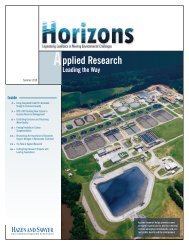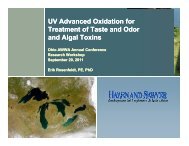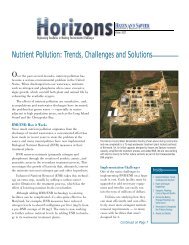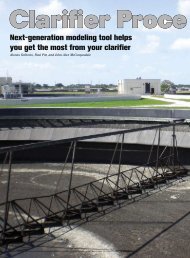full article - Hazen and Sawyer
full article - Hazen and Sawyer
full article - Hazen and Sawyer
You also want an ePaper? Increase the reach of your titles
YUMPU automatically turns print PDFs into web optimized ePapers that Google loves.
Treatment<br />
http://dx.doi.org/10.5991/OPF.2012.38.0068<br />
Edward Khuns III <strong>and</strong> Glenn Allen are with the city of<br />
Peekskill (www.cityofpeekskill.com), Peekskill, N.Y.<br />
Julie A. Herzner <strong>and</strong> Christakis Roumbas are with <strong>Hazen</strong><br />
<strong>and</strong> <strong>Sawyer</strong> (www.hazen<strong>and</strong>sawyer.com), New York.<br />
Conventional DAF Meets<br />
Site-Specific Requirements<br />
Antiquated equipment, elevated DBP levels, <strong>and</strong> capacity constraints led<br />
a New York utility to analyze two DAF treatment processes.<br />
BY Edward Khuns III, Glenn Allen, Julie A. Herzner, AND Christakis Roumbas<br />
The city of Peekskill, N.Y.,<br />
faced major challenges. The<br />
city’s slow s<strong>and</strong> filtration facility,<br />
the Peekskill Water Treatment<br />
Plant, was built more than 100 years ago;<br />
the city’s distribution system had elevated<br />
disinfection by-product (DBP) levels;<br />
<strong>and</strong> capacity <strong>and</strong> hydraulic constraints<br />
limited expansion. Any plan to update<br />
the facility had to consider building<br />
height restrictions because of a nearby<br />
residential neighborhood, minimizing<br />
excavation because of underlying<br />
bedrock, <strong>and</strong> limited space, as the old<br />
plant needed to remain operational<br />
during construction.<br />
Technology Selection<br />
Wiccopee Reservoir, Peekskill’s supply<br />
source, is eutrophic with seasonal algae<br />
blooms, but the water supply to the treatment<br />
plant has low raw-water turbidity<br />
TREATMENT OPTIONS<br />
What Is Dissolved Air Flotation?<br />
<strong>and</strong> low-to-moderate total organic carbon<br />
(TOC).<br />
The first step—technology evaluation—identified<br />
processes that would<br />
meet existing <strong>and</strong> anticipated drinking<br />
water regulations:<br />
■■<br />
■■<br />
■■<br />
■■<br />
Membrane treatment for p<strong>article</strong><br />
removal, followed by free-chlorine <strong>and</strong><br />
chloramine residual<br />
Chemical coagulation <strong>and</strong> flocculation<br />
applied directly to membrane filtration,<br />
with free-chlorine residual<br />
Chemical coagulation, ballasted flocculation,<br />
<strong>and</strong> high-rate settling, followed<br />
by rapid granular filtration <strong>and</strong> chlorine<br />
disinfection<br />
Chemical coagulation, flocculation,<br />
<strong>and</strong> dissolved air flotation (DAF) clarification,<br />
followed by rapid granular filtration<br />
<strong>and</strong> chlorine disinfection<br />
Based on comparative cost estimates<br />
<strong>and</strong> considering a raw-water supply that’s<br />
A proven water treatment technology, dissolved air flotation (DAF) offers significantly<br />
lower capital costs than most other clarification processes. The DAF process separates<br />
flocculated p<strong>article</strong>s <strong>and</strong> contaminants from water by floating them to the surface for<br />
removal. Flotation is achieved by injecting a pressurized, air-saturated recycle stream.<br />
This recycle stream, injected into the inlet of the DAF units, results in a sudden reduction<br />
in pressure, triggering the release of air in the form of micro-bubbles that attach to flocculated<br />
p<strong>article</strong>s, form a dense foam, <strong>and</strong> float the p<strong>article</strong>s to a tank’s surface where<br />
they’re removed by a skimmer.<br />
subject to seasonal turnover <strong>and</strong> algae<br />
problems, DAF was selected as the best<br />
treatment option. DAF process optimization<br />
<strong>and</strong> selection of design criteria were<br />
evaluated during pilot testing.<br />
Pilot Study<br />
The pilot study assessed two types of DAF<br />
processes—conventional DAF treatment<br />
<strong>and</strong> a proprietary high-rate DAF technology—followed<br />
by filtration. Pilot trailers<br />
were located adjacent to the plant’s proposed<br />
location, about 25 ft uphill from<br />
Campfield Reservoir, the equalization reservoir<br />
for Peekskill’s pumped supply.<br />
Raw water was pumped from middepth<br />
of the reservoir <strong>and</strong> directed to the<br />
conventional DAF pilot trailer <strong>and</strong> the<br />
high-rate pilot trailer. Influent to the conventional<br />
DAF trailer followed a single<br />
process train, consisting of in-line static<br />
mixers, two-stage flocculation, <strong>and</strong> DAF,<br />
followed by filtration. The high-rate DAF<br />
trailer was equipped with a single process<br />
train consisting of a mechanical mixer,<br />
three-stage flocculation, <strong>and</strong> DAF. Because<br />
the high-rate DAF trailer wasn’t equipped<br />
with filters, two of the four filter columns<br />
located in the conventional DAF were used<br />
to filter the high-rate DAF-floated water.<br />
Waste flow from each pilot trailer was discharged<br />
by gravity to a sewer connection.<br />
Two loading rates were tested for each<br />
DAF process—6 gpm/ft 2 <strong>and</strong> 7.5 gpm/ft 2<br />
14 Opflow November 2012 www.awwa.org/opflow
The new Peekskill Water<br />
Treatment Plant faced several<br />
design complexities, including<br />
connecting the new facility <strong>and</strong><br />
high-service pumps to the existing<br />
clearwell without interrupting<br />
service; installing a new intake;<br />
<strong>and</strong> managing a project site<br />
underlain with bedrock, requiring<br />
costly excavation. An awardwinning<br />
approach was used to<br />
optimize the conventional DAF<br />
process <strong>and</strong> include a pump<br />
station that allowed the plant<br />
to be constructed at grade,<br />
minimizing excavation.<br />
photograph: <strong>Hazen</strong> <strong>and</strong> <strong>Sawyer</strong><br />
for conventional DAF <strong>and</strong> 12 gpm/ft 2 <strong>and</strong><br />
16 gpm/ft 2 for high-rate DAF. The lower<br />
loading rates (6 gpm/ft 2 <strong>and</strong> 12 gpm/ft 2 )<br />
averaged lower floated-water turbidities;<br />
filtered water quality parameters varied.<br />
The pilot data confirmed that both<br />
DAF processes, followed by filtration,<br />
provided high-quality finished water (low<br />
filtered-water turbidity <strong>and</strong> high p<strong>article</strong><br />
removal) <strong>and</strong> maintained adequate filterrun<br />
lengths. Filtered-water turbidity was<br />
consistently less than 0.1 ntu. Log p<strong>article</strong><br />
removal ranged from 1.1 to 2.8 for optimized<br />
runs. Unit filter run volumes consistently<br />
exceeded the 7,500-gal/ft 2 pilot<br />
goal.<br />
Iron <strong>and</strong> manganese in the filtered<br />
water were frequently undetectable <strong>and</strong><br />
reliably less than the 0.02-mg/L pilot<br />
goal. Organics removal ranged from<br />
40 percent to 50 percent for specialized<br />
TOC testing, <strong>and</strong> ultraviolet analysis indicated<br />
removal greater than 75 percent.<br />
These high removal rates would help<br />
the city meet federal st<strong>and</strong>ards regarding<br />
DBP formation.<br />
The pilot data confirmed both processes<br />
provided high-quality, lowturbidity<br />
finished water <strong>and</strong> high p<strong>article</strong><br />
removal, with adequate filter run-lengths.<br />
Therefore, further evaluations were conducted<br />
to determine which technology<br />
was best suited for the site’s space, height,<br />
<strong>and</strong> depth requirements. Conceptual<br />
building <strong>and</strong> site layouts were prepared<br />
for both processes, <strong>and</strong> comparative cost<br />
estimates were developed.<br />
DESIGN AND CONSTRUCTION<br />
Computational fluid dynamics (CFD) was<br />
used to optimize facility design <strong>and</strong> minimize<br />
plant footprint <strong>and</strong> excavation depth<br />
<strong>and</strong> extent. Flocculation tanks of the same<br />
width were dedicated to the respective<br />
DAF–filtration tanks. This innovative layout<br />
enabled pinpoint floc to form <strong>and</strong> be<br />
removed in less time, allowing for more<br />
compact flocculator layout <strong>and</strong> decreased<br />
structural <strong>and</strong> excavation costs. CFD modeling<br />
confirmed that this arrangement<br />
wouldn’t result in uneven flow distribution<br />
to the DAF saturator zone. CFD modeling<br />
was also used to refine spacing of<br />
the transition baffles between the flocculation<br />
basins <strong>and</strong> DAF tanks, providing<br />
efficient layout.<br />
Although high-rate DAF resulted in<br />
a smaller flotation area, it required a<br />
deeper tank <strong>and</strong> larger flocculation area<br />
than conventional DAF. Evaluations demonstrated<br />
that the conventional DAF process<br />
was cost-effective <strong>and</strong> required less<br />
space than high-rate DAF. Therefore, conventional<br />
DAF was selected for design<br />
<strong>and</strong> construction.<br />
Because the high-rate DAF process<br />
operates at much higher loading rates<br />
than conventional DAF, it seems intuitive<br />
that the high-rate process would<br />
save money because of its smaller footprint.<br />
However, analysis demonstrated<br />
that, after optimizing the flocculation<br />
basin arrangement, there was little difference<br />
in overall footprints of the two processes,<br />
<strong>and</strong> the high-rate process didn’t<br />
meet the owner’s footprint or cost–benefit<br />
criteria.<br />
SYSTEM BENEFITS<br />
The new plant began serving customers<br />
in May 2010. The cost-efficient<br />
treatment process effectively removes<br />
organics, producing finished water that<br />
consistently meets DBP limits, which<br />
the old plant had seasonally exceeded.<br />
The quality of water from the new plant<br />
significantly improves public health for<br />
Peekskill residents.<br />
The American Council of Engineering<br />
Companies recognized the new facility<br />
with a 2011 Gold Award because it<br />
exhibits the successful evaluation of<br />
alternate treatment processes, pilot-scale<br />
studies of options within the selected process,<br />
optimization of the selected treatment,<br />
<strong>and</strong> life-cycle cost analysis. The<br />
approach established the most costeffective<br />
treatment alternative <strong>and</strong> optimized<br />
plant design, taking into account<br />
considerable site constraints <strong>and</strong> the need<br />
to provide continuous service throughout<br />
construction.<br />
www.awwa.org/opflow November 2012 Opflow 15








